Last Updated on March 12, 2024 by Rebecca Huff
Do you love delicious, homemade pasta? There's nothing quite like the satisfaction of creating a beautiful plate of ravioli from scratch. But what if you don't have a pasta machine?
Fear not! In this article, I'll show you how to handcraft mouthwatering ravioli without the need for fancy equipment. Although I have a pasta machine, I have taught many others how to prepare delicious homemade pasta, including ravioli, for the first time without special equipment.
Crafting homemade ravioli is a labor of love, but the results are well worth it.
With just a few simple ingredients you probably already have on hand and some patient rolling, you can create tender, pillowy pockets of flavor that rival those from your favorite Italian restaurant. Whether you prefer classic cheese-filled ravioli or want to get creative with unique fillings, I've got you covered.
I'll walk you through each step of the process, from making the pasta dough to shaping and filling the ravioli. You'll find helpful tips that ensure your handmade ravioli turns out perfectly every time.
So, put on your apron and get ready to impress your family and friends with homemade ravioli that's bursting with flavor. Let's dive in and unleash your inner pasta chef!
Tools and Equipment for Homemade Ravioli
Before I get into the process of making homemade ravioli, let's make sure you have all the necessary tools and equipment. While a pasta machine is often used to roll out the dough, a rolling pin will work just fine.
Here are the true basics you need: a rolling pin, knife, fork, and pot for boiling water. The list below is in order of importance when it comes to making homemade ravioli:
- Rolling Pin: A sturdy rolling pin is essential for rolling out the fresh pasta dough to the desired thickness.
- Baking Sheet: You'll need a baking sheet to lay out the finished ravioli before cooking.
- Large Pot: A large pot is needed to boil the ravioli.
- Slotted Spoon: Use a large slotted spoon to remove the cooked ravioli from the boiling water. Although you can get by with a strainer, a slotted spoon is less likely to damage your delicate ravioli.
- Pastry Brush: A pastry brush will come in handy for sealing the edges of the ravioli. Again, if you don’t have a pastry brush, simply dip your fingertip in a small bowl of water – that’s how Nonna does it in Italy!
- Ravioli Cutter: This handy tool will help you shape and cut the ravioli into uniform pieces; however, if you don’t have one, you can use a knife, a fluted or straight pastry cutter, or a pizza cutter. (I have a round one from Williams Sonoma that I love!)
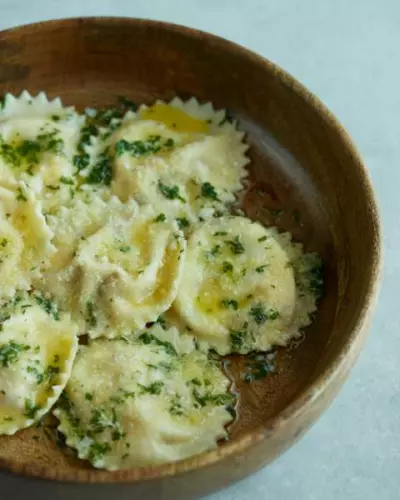
Shop my Pasta Essentials Storefront on Amazon to find my favorite products. Now, let's move on to the ingredients for the homemade ravioli dough. I’ll include the recipe I use for lasagna, ravioli, and other noodles in this post as well.
Ingredients for Homemade Ravioli Dough
You'll only need a few simple ingredients to make the perfect homemade ravioli dough. Here's what you'll need:
- All-Purpose Flour: You'll need about 2 cups of all-purpose flour for the dough.
- Eggs: You’ll use large eggs to bind the dough together; sometimes, I add an extra egg yolk to make the dough richer in texture and flavor.
- Salt: A pinch of salt enhances the dough's flavor; my favorite is Himalayan Sea Salt.
- Water: You may need a little water to adjust the consistency of the dough if necessary.
- Olive Oil: A tablespoon of olive oil will help keep the dough moist and pliable. (I consider this an optional but nice-to-have ingredient and do not include it when I teach pasta-making classes.)
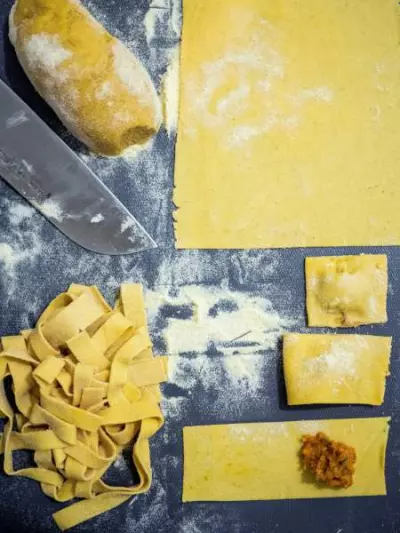
Sometimes, it is easier to do a rectangle foldover when making ravioli for the first time or if you find it difficult. Leftover dough can be made into knife-cut noodles.
Here’s one simple pasta dough recipe:
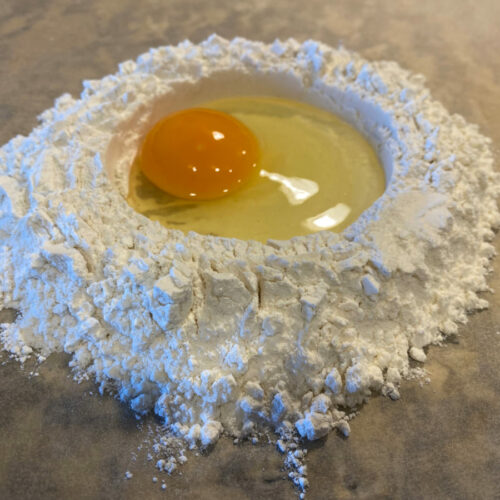
Simple Pasta Dough
Ingredients
- 3/4 cup all-purpose flour
- 1 egg
- 1 egg yolk
- water as needed
- pinch salt
Instructions
- Measure flour directly onto a large wooden cutting board or marble or granite counter top, make a well or volcano in the middle of the flour.
- Crack egg and egg yolk directly into the well you just made.
- Add a three finger pinch of salt.
- Using your fingers or a fork mix egg, gradually bringing in flour, little by little until it forms a shaggy dough.
- Begin folding and kneading the dough until it becomes uniform, adding a few drops of water as necessary.
- Knead for five minutes, minimum, then cover (airtight) and allow to rest for 30 minutes before rolling out the dough.
Making the Perfect Homemade Ravioli Dough
1. Prepare your work surface: Start by clearing a large, clean work surface and dust it lightly with flour.
2. Combine the ingredients: Whisk together the flour and salt in a large mixing bowl. Create a well in the center and crack the eggs into it. Add the olive oil as well.
3. Mix and knead: Gradually incorporate the flour into the eggs and olive oil mixture until a dough forms. Use your hands to knead the dough until it becomes smooth and elastic. If the dough feels too dry, add a little water, one tablespoon at a time, until the desired consistency is reached.
4. Rest the dough: Wrap the dough in plastic wrap and let it rest at room temperature for at least 30 minutes. This will allow the gluten to relax and make the dough easier to roll out.
Our fresh homemade ravioli dough is ready, and it's time to move on to the exciting part – filling options for your ravioli.
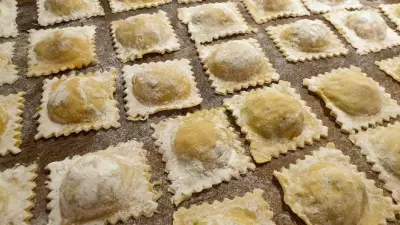
Filling Options for Homemade Ravioli
When it comes to filling homemade ravioli, the possibilities are endless. You can stick to classic fillings like ricotta cheese or get creative with unique combinations.
Here are a few filling ideas to get you started:
- Classic Cheese: Mix ricotta cheese, grated Parmesan, chopped fresh herbs like basil or parsley, and a pinch of salt and pepper.
- Spinach and Mushroom: Sauté finely chopped mushrooms and spinach until cooked through. Mix them with ricotta cheese, garlic, and a sprinkle of nutmeg.
- Butternut Squash: Roast butternut squash until tender, then mash it with ricotta cheese, cinnamon, and a touch of brown sugar.
- Lobster and/or Shrimp: Sauté diced lobster and shrimp in butter until cooked. Mix them with cream cheese, lemon zest, and chopped chives.
Once you've chosen your filling, you can shape, fill, and seal the ravioli.
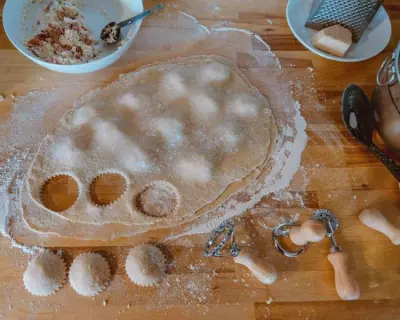
Shaping and Filling Homemade Ravioli
You may have noticed that homemade ravioli comes in a variety of shapes. There are two ways you can make easy ravioli shaped into circles or squares. If you don’t have a biscuit cutter to make circular ravioli, you can use a knife, pastry, or pizza cutter to make square ravioli.
You’ve followed the pasta recipe and have your dough ready to go. Get started following these steps:
1. Roll out the dough: Divide the rested dough into smaller portions and roll out each portion into a thin sheet using a rolling pin. Aim for a thickness of about 1/8 inch. Always keep your unused, unrolled dough wrapped in an airtight way, either resting on a plate with a bowl over the top or wrapped in clingfilm or beeswax wrap.
2. Place the filling: Spoon small amounts of filling onto one half of the rolled-out sheet of pasta dough, spacing them evenly. Be careful not to overfill, making it difficult to seal the ravioli.
3. Seal the edges: Gently lay the second sheet of rolled pasta dough over the filling, lining up the edges. Use your fingers or a fork to press down and seal the edges, ensuring no air is trapped inside. (I like to use my finger or a pastry brush dipped in a little water to ensure the two sheets of dough form a good seal.)
4. Cut the ravioli: Use a ravioli cutter or a sharp knife to cut the sealed dough into individual ravioli. At this point, you may crimp the edges of the ravioli with a fork if you desire. Place the finished ravioli on a baking sheet lined with parchment paper. It can also be helpful to sprinkle the paper with a bit of flour or rice flour to keep it from sticking.
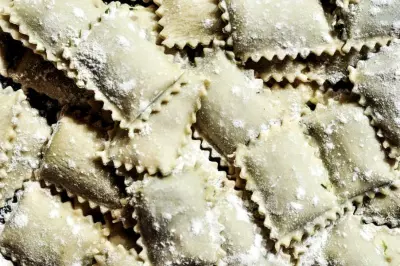
This is a good time to note that you can freeze your ravioli at this stage and cook them at a later date. Just make sure to freeze ravioli in a single layer so they don’t stick together. Frozen ravioli can be prepared by dropping them into boiling water until cooked through.
Now you are ready to start cooking your beautifully crafted homemade ravioli.
Cooking and Serving Homemade Ravioli
1. Boil the ravioli: Bring a large pot of generously salted water to a rolling boil. Plunge the ravioli into the boiling water and cook for about 3-4 minutes, or until they float to the surface. Check one of the ravioli for doneness before draining the water.
2. Drain and serve: Using a slotted spoon, carefully remove the cooked ravioli from the pot and transfer them to a serving dish. Serve the ravioli immediately with your favorite sauce, such as marinara, alfredo, pesto, or a simple butter sauce. Garnish with grated Parmesan cheese and fresh herbs if desired.
Variations and Creative Twists on Homemade Ravioli
While classic cheese-filled ravioli is always a crowd-pleaser, don't hesitate to get creative and experiment with different flavors and fillings. Here are a few unusual filling combos to inspire you:
- Purple Sweet Potato and Sage: Roast sweet potatoes (orange or purple) and mash them with ricotta cheese, fresh sage, and a sprinkle of cinnamon.
- Pear and Blue Cheese Ravioli: For a sweet and savory filling, mix crumbled Blue cheese, chopped pears, and a drizzle of honey.
- Beef and Mushroom: Sauté ground beef and finely chopped mushrooms until cooked. Mix them with mozzarella cheese, garlic, and Italian seasoning.
Often, I make fresh ravioli with whatever cheeses and herbs I have on hand. One of my favorite “clean out the cheese drawer” ravioli fillings had fresh basil with gorgonzola and goat cheese. It was heavenly.
Pair your homemade ravioli recipe with a simple tomato sauce made from scratch or your favorite jar of sauce. (I won’t tell Nonna!)

Let your imagination run wild and create unique ravioli flavor combinations. If you like it, go for it.
Troubleshooting Common Issues with Homemade Ravioli
Making homemade ravioli is rewarding, but it can sometimes come with challenges. Here are a few common issues you may encounter and how to troubleshoot them:
- Dough too dry: If your dough feels too dry and crumbly, add a little water, one tablespoon at a time, until the desired consistency is reached. Remember that your dough will become more hydrated as you allow it to rest for 30 minutes before rolling.
- Filling leaking out: If your filling leaks out of the ravioli during cooking, seal the edges properly using water and pressure. Press down firmly to ensure a tight seal. There’s not much you can do if this happens during the boiling process, but as long as the cheese filling is still in most of your ravioli, you’ll still have a nice meal to enjoy.
- Ravioli sticking together: If your ravioli is sticking together, make sure to dust the baking sheet with flour, rice flour or semolina flour to prevent them from sticking.
Remember, practice makes perfect, so don't be discouraged if your first attempt doesn't turn out exactly as planned. With time and experience, you'll become a ravioli-making expert. You can go back and follow these step-by-step instructions each time you practice the art of homemade ravioli.
Conclusion and Final Thoughts on How to Make Ravioli
Crafting homemade ravioli without a machine is a rewarding culinary adventure that allows you to unleash your inner pasta chef. From making the perfect dough to shaping and filling the ravioli, each step is an opportunity to create something truly delicious.
Cutting down on prep time: As you become more prodicient at making pasta dough, you might consider getting a pasta attachment for your Kitchenaid stand mixer, if you have one. If you enjoy cooking, consider adding a Kitchenaid stand mixer and pasta attachment to your wish list. I prefer this option over a counter top attachment style pasta roller as it is more stable and doesn’t risk damage to your counter tops.
If you have a food processor, you can also use it to mix your pasta dough before rolling it by hand.
Well, what are you waiting for, put on your apron, gather your ingredients and tools, and dive into the world of handmade ravioli. Whether you stick to classic fillings or get creative with unique combinations, the joy of crafting your own ravioli is unmatched. The time and effort you put into creating these mouthwatering pockets of flavor will be well worth it when you take your first bite.
Let the pasta-making adventure begin!


 Making Recipes from Gilmore Girls with Larisa – EatingGilmore
Making Recipes from Gilmore Girls with Larisa – EatingGilmore
Leave a Reply
You must be logged in to post a comment.